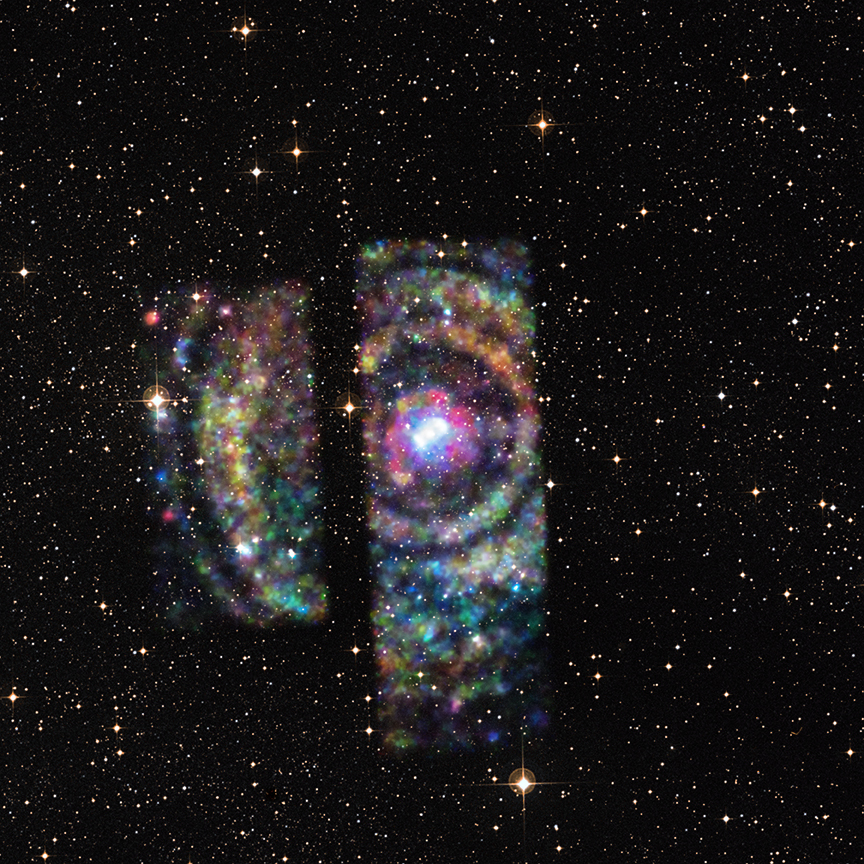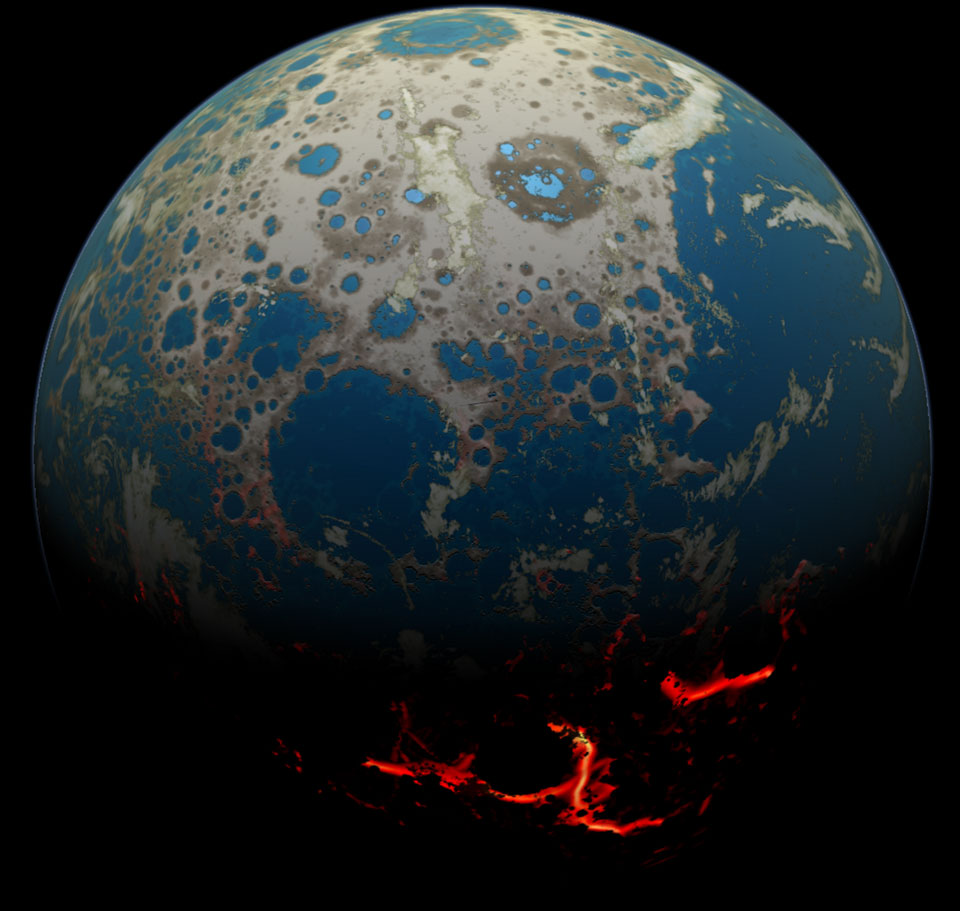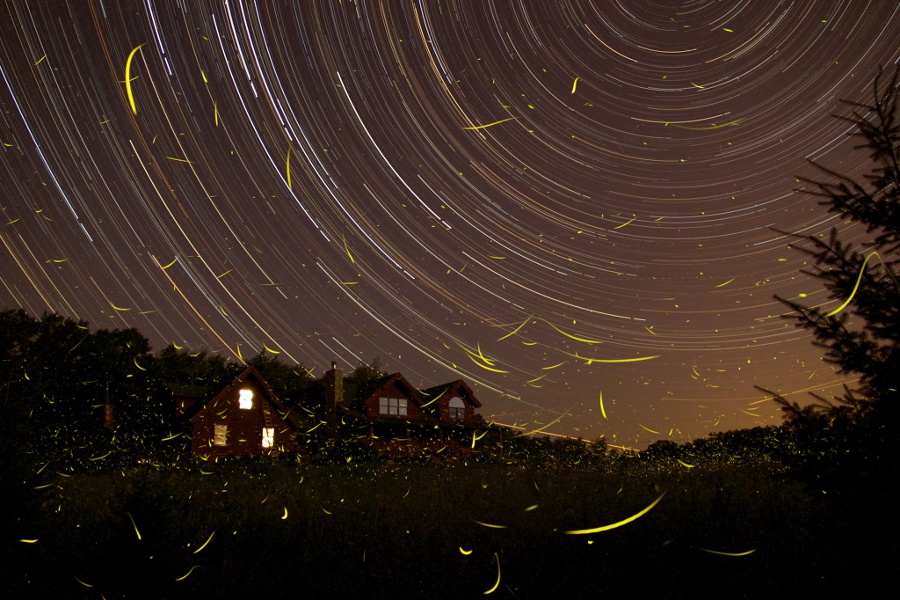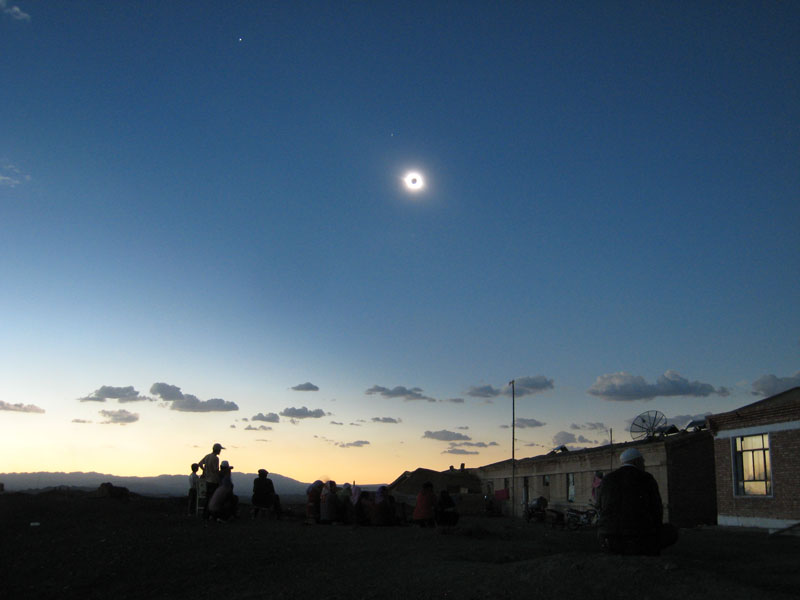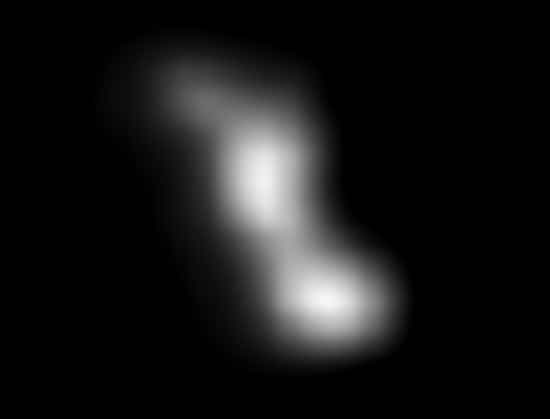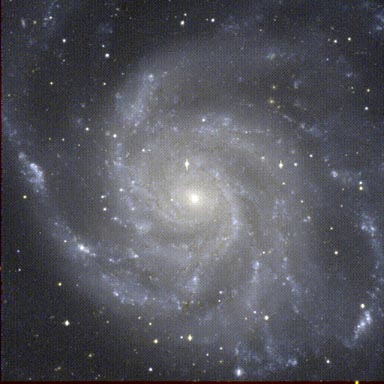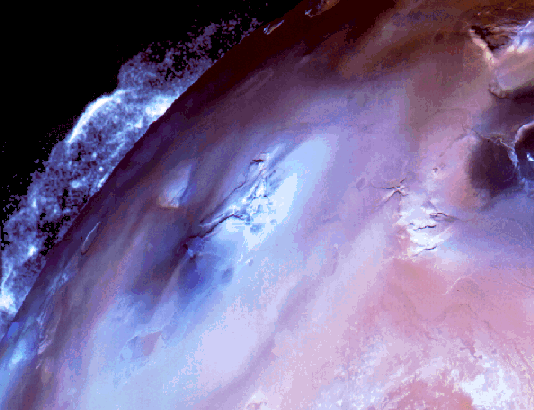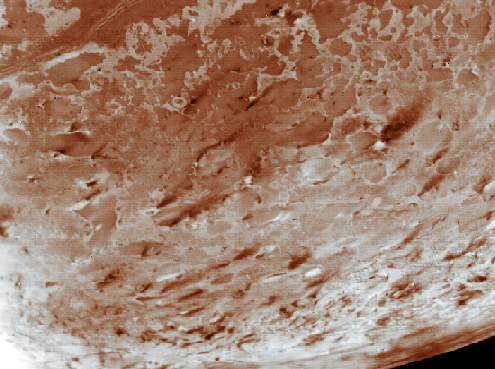| << Previous | Index | Next >> |
2015 Circinus X-1 is an X-ray binary star known for its erratic variability. In the bizarre Circinus X-1 system, a dense neutron star, the collapsed remnant of a supernova explosion, orbits with a more ordinary stellar companion. Observations of the X-ray binary in months following an intense X-ray flare from the source in 2013 progressively revealed striking concentric rings - bright X-ray light echoes from four intervening clouds of interstellar dust. In this X-ray/optical composite, the swaths of Chandra Observatory X-ray image data showing partial outlines of the rings are in false colors. Remarkably, timing the X-ray echoes, along with known distances to the interstellar dust clouds, determines the formerly highly uncertain distance to Circinus X-1 itself to be 30,700 light-years.
2014 No place on Earth was safe. Four billion years ago, during the Hadean eon, our Solar System was a dangerous shooting gallery of large and dangerous rocks and ice chunks. Recent examination of lunar and Earth bombardment data indicate that the entire surface of the Earth underwent piecemeal upheavals, hiding our globe's ancient geologic history, and creating a battered world with no remaining familiar land masses. The rain of devastation made it difficult for any life to survive, although bacteria that could endure high temperatures had the best chance. Oceans thought to have formed during this epoch would boil away after particularly heavy impacts, only to reform again. The above artist's illustration depicts how Earth might have looked during this epoch, with circular impact features dotting the daylight side, and hot lava flows visible in the night. One billion years later, in a calmer Solar System, Earth's first supercontinent formed.
2013
Click to play embedded YouTube video.
Video Credit: NASA/Johns Hopkins University Applied Physics Laboratory/Carnegie Institution of Washington
2012
2011 Fix your digital camera to a tripod, start a long series of exposures, and you too can record star trails. The concentric arcs traced by the stars as planet Earth rotates on its axis often produce dreamlike scenes in otherwise familiar situations. Fall asleep, though, and the results might surprise you. Setting up on a summer night, photographer Mike Rosinski began his exposures, initially planning to capture about 45-55 minutes worth of star trails from his yard in Hartland, Michigan, USA. But he dozed, only to awaken some 3 hours later to find his camera had continued to run until the battery died. Composing the resulting images, the graceful concentric star trails were expected, along with light from a late rising Moon glinting on windows. Still, as he slept on the warm night a blizzard of yellow streaks flooded the scene, not left by fairies but fireflies.
2010
2009 The sharpest image ever of Betelgeuse shows a mammoth star that is slowly evaporating. Betelgeuse (sounds a lot like "beetle juice"), also known as Alpha Orionis, is one of the largest and brightest stars known. The star is a familiar orange fixture easily visible to the unaided eye toward the constellation of Orion. This recent image from the Very Large Telescope in Chile resolves not only the face of Betelgeuse, but a large and previously unknown plume of surrounding gas. This plume gives fresh indications of how the massive star is shedding mass as it nears the end of its life. Conversely, a series of previous observations indicate that the surface of Betelgeuse has noticeably shrunk, on the average, over the past decade. If Betelgeuse, a red supergiant star about 640 light years distant, were placed at the center of our Solar System, the plume would extend past the orbit of Jupiter. Since Betelgeuse is known to change its brightness irregularly, future observations may determine if changes its appearance irregularly as well. Betelgeuse is a candidate to undergo a spectacular supernova explosion almost anytime in the next few thousand years.
2008 What's that black dot over the Sun? The Moon. This past weekend, the Sun went dark during the day as the Moon completely covered it. The total solar eclipse was visible over a thin swath of Earth extending from northern Canada to China. As shown above, many sky enthusiasts gathered to witness the total or partial solar eclipse, which lasted only a few minutes. The above image was taken during totality near Barkol in Xinjiang, China, with the Barkol Shan mountain range visible on the horizon. Although the brightest parts of the Sun are covered, the normally invisible corona of hot gas surrounding the Sun became prominent. Just to the upper left of the Moon darkened Sun are planets Mercury and Venus. The increased darkening of the sky toward the right indicates the darkened atmosphere created by the passing shadow cone of the total solar eclipse. The next total solar eclipse will occur next July and be visible in parts of India and China.
2007 What causes the black dots on dunes on Mars? As spring dawned on the Northern Hemisphere of Mars in 2004, dunes of sand near the poles begin to defrost. Thinner regions of ice typically thaw first revealing sand whose darkness soaks in sunlight and accelerates the thaw. The process might involve sandy jets exploding through the thinning ice. By summer, the spots expanded to encompass the entire dunes that were then completely thawed and dark. The carbon dioxide and water ice actually sublime in the thin atmosphere directly to gas. Taken in mid-July, the above image shows a field of spotted polar dunes spanning about 3 kilometers near the Martian North Pole. Today, the future of Mars rovers Spirit and Opportunity remains unknown windy dust storms continue to starve them of needed sunlight.
2006 In this beautiful celestial still life composed with a cosmic brush, dusty nebula NGC 2170 shines at the upper left. Reflecting the light of nearby hot stars, NGC 2170 is joined by other bluish reflection nebulae and a compact red emission region against a backdrop of stars. Like the common household items still life painters often choose for their subjects, the clouds of gas, dust, and hot stars pictured here are also commonly found in this setting - a massive, star-forming molecular cloud in the constellation Monoceros. The giant molecular cloud, Mon R2, is impressively close, estimated to be only 2,400 light-years or so away. At that distance, this canvas would be about 15 light-years across.
2005 Although it looks like fiction, this artist's vision of sunset on an alien world is based on fact -- the recent discovery of a hot, jupiter-sized planet orbiting in triple star system HD 188753. Only 149 light-years away in the constellation Cygnus, HD 188753's massive planet was detected by astronomer Maciej Konacki after analyzing detailed spectroscopic data from the Keck Observatory. The large planet itself is depicted at the upper left in this imagined view from the well-illuminated surface of a hypothetical rocky moon. From this perspective, the closest, hottest and most massive star in the triple system, a star only a little hotter than the Sun, has set below distant peaks. The two other suns nearing the horizon are both cooler and farther from the large planet. While other hot, jupiter-like planets are known to orbit nearby stars, the "crowded" multiple star nature of this system challenges current theories of planet formation.
2004 Sprawling across hundreds of light-years, emission nebula IC 1396 mixes glowing cosmic gas and dark dust clouds. Stars are forming in this area, only about 3,000 light-years from Earth. This particularly colorful view of the region is a composite of digital images recorded through narrow band filters. The filters actually block out most of the light ... but narrowly transmit wavelengths characteristic of specific glowing atoms in the nebula. In fact, the color scheme used here makes it easy to trace some of the elements which contribute to the emission from IC 1396. Emission from sulfur atoms is shown in red, hydrogen atoms green, and oxygen in blue. The beautiful and useful result is still very different from what the eye might see. IC 1396 lies in the high and far off constellation of Cepheus.
2003 How does a space shuttle that landed in California get back to Florida for its next launch? The answer is by ferry. NASA operates two commercial Boeing 747 airplanes modified to carry a space shuttle on their backs. Designated officially as Shuttle Carrier Aircraft or SCA, the 747s were made for commercial flights but bolstered by NASA with several struts, stabilizers, and electronic monitors. Spanning about 70 meters in length, the two aircraft's combined mass is nearly 150,000 kilograms. Pictured above, the space shuttle Atlantis is shown being ferried back to NASA Kennedy Space Center in Florida in September 1998.
2002 This aurora was a bit of a surprise. For starters, last Friday morning, no intense auroral activity was expected at all. Possibly more surprising, however, the aurora appeared to show an usual structure of green rays from some locations. In the above image, captured from North Dakota, USA, a picket fence of green rays stretches toward the horizon. Mirroring the green rays is a red band, somewhat rare in its own right. Lights from the cities of Bismarck and Mandan are visible near the horizon. Large sunspot groups indicate that activity from the currently active Sun is relatively likely, possibly causing other streams of energetic particles to cascade onto the Earth and so causing more auroras.
2001 Like a butterfly, a white dwarf star begins its life by casting off a cocoon that enclosed its former self. In this analogy, however, the Sun would be a caterpillar and the ejected shell of gas would become the prettiest of all! The above cocoon, the planetary nebula designated NGC 2440, contains one of the hottest white dwarf stars known. The white dwarf can be seen as the bright dot near the photo's center. Our Sun will eventually become a "white dwarf butterfly", but not for another 5 billion years. The above false color image and was post-processed by Forrest Hamilton.
2000 What does a comet nucleus look like? Formed from the primordial stuff of the solar system, it is thought to resemble a very dirty iceberg. But for active comets, telescopic images only reveal the surrounding cloud of gas and dust, the comet's coma, and the characteristic cometary tails. In 1986, the European spacecraft Giotto encountered the nucleus of Halley's comet as it approached the sun. Data from Giotto's camera was used to generate this enhanced image of the potato shaped nucleus which measures roughly 15 kilometers across. It shows surface features on the dark nucleus against the bright background of the coma as the icy material is vaporized by the Sun's heat. Every 76 years Comet Halley returns to the inner solar system and each time the nucleus sheds about a 6 meter deep layer of its ice and rock into space. This debris composes Halley's tails and leaves an orbiting trail responsible for the Orionids meteor shower.
1999 NASA probe Deep Space 1 zoomed past asteroid 9969 Braille last week as it continued to test its new ion drive in the inner Solar System. The flyby was the closest approach a spacecraft has ever made to an asteroid. Looking back afterwards, DS1 took the above picture. Formerly known as 1992 KD, the 9969th asteroid discovered was renamed in honor of Louis Braille, a pioneer in written communication for the blind. 9969 Braille is thought by some to have collided with asteroid Vesta in the distant past and broken up, providing debris for many of the meteorites that fall to Earth. Asteroid 9969 Braille rotates only once in 9 days, and has an orbit greatly tilted relative to the ecliptic plane of the planets.
1998 This remarkable line of 13 closely spaced craters on Jupiter's moon Ganymede was photographed by the Galileo spacecraft in 1997. The picture covers an area about 120 miles wide and the chain of craters cuts across a sharp boundary between dark and light terrain. What caused this crater chain? During the exploration of the Solar System, crater chains like this one have been discovered in several places and were considered mysterious until a dramatic object lesson was offered by comet Shoemaker-Levy 9. In 1994 many denizens of planet Earth watched as huge pieces of this torn comet slammed into Jupiter itself in a spectacular series of sequential impacts. It is very likely that similar torn comets from the early history of the Solar System are responsible for this and other crater chains.
1997 Why do many galaxies appear as spirals? A striking example is M101, shown above, whose relatively close distance of about 22 million light years allow it to be studied in some detail. Recent evidence indicates that a close gravitational interaction with a neighboring galaxy created waves of high mass and condensed gas which continue to circle the galaxy. These waves compress existing gas and cause star formation. One result is that M101, also called the Pinwheel Galaxy, has several extremely bright star-forming regions (called HII regions) spread across its spiral arms. M101 is so large that its immense gravity distorts smaller nearby galaxies.
1996 Jupiter's moon Io has active volcanoes. The Voyager spacecraft caught several erupting when they passed the energetic moon in 1979. In the above picture, several of Io's volcanoes are visible and one is seen actually erupting. Debris from this explosive event can be seen on the upper left of the photo, just beyond Io's edge. Io's volcanism is thought to be caused by the large tidal distortions raised by Jupiter, Europa, and Ganymede. These tides stretch Io, cause internal friction, and thus heat the interior. The hot interior then expands and forces its way out through volcanoes. Currently, the spacecraft Galileo is orbiting Jupiter and photographing Jupiter's Galilean moons.
1995 In August of 1989 NASA's Voyager 2 spacecraft passed by Neptune, the most distant of the solar system's gas giant planets. Its encounter with Neptune climaxed with its closest approach to Neptune's largest moon Triton. From a distance of about 24,000 miles the robot space probe surveyed Triton's surface, whose temperature averages nearly -400 degrees Fahrenheit, and discovered surprising evidence of a complex and active world. For example, the prominent dark streaks in this image seem to come from small volcanoes and may consist of nitrogen frost mixed with organic compounds ejected during geyser-like eruptions. For more information about Triton, see Calvin J. Hamilton's Triton page.
| << Previous | Index | Next >> |
